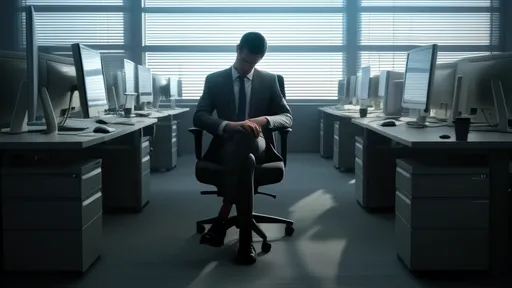The Silent Crisis: How Prolonged Sitting Damages Your Brain and Why Your Spine's Warning Signs Go Unnoticed
Modern lifestyles have tethered us to chairs in ways our ancestors would find incomprehensible. The average office worker now spends between 8 to 10 hours seated daily, with many remaining stationary for prolonged periods without movement. While public health campaigns frequently highlight the cardiovascular risks of sedentary behavior, emerging research reveals a more insidious consequence - our sitting habits may be literally shrinking our brains while our bodies scream warnings we've learned to ignore.
Neuroscience studies using advanced imaging show that prolonged sitting correlates with decreased thickness in the medial temporal lobe, the brain region crucial for memory formation. This structural change appears independent of exercise habits, suggesting that gym sessions after work don't fully counteract the damage done by hours of chair confinement. The mechanism appears related to reduced blood flow and lower oxygen delivery to the brain when we remain seated for extended periods.
Meanwhile, our lumbar spines send distress signals most of us have been conditioned to dismiss. That dull ache in your lower back after two hours at your desk? The occasional sharp twinge when you finally stand up? These aren't normal consequences of aging or harmless discomfort - they're your body's equivalent of flashing warning lights. Physical therapists report that by the time most patients seek help for back pain, their spines have been sending signals for months or years that were masked by painkillers, ignored due to work pressures, or simply accepted as inevitable.
The connection between spinal health and brain function proves more intimate than previously believed. Restricted movement in the lumbar region affects cerebrospinal fluid circulation, potentially impairing the brain's waste removal system. Some researchers speculate this may contribute to the buildup of proteins associated with neurodegenerative diseases. Your chair-bound posture doesn't just hurt your back - it may be setting the stage for cognitive decline decades later.
Corporate wellness programs often focus on ergonomic equipment without addressing the root problem - the cultural expectation of continuous sitting. Standing desks have become popular solutions, but these merely replace one static position with another. The human body evolved for varied movement, not for maintaining any single posture for hours. Even those who exercise regularly face risks if their workouts bookend long periods of motionless sitting.
Warning signs from your lumbar spine follow a predictable escalation that most ignore until crisis strikes. Initial stiffness gives way to intermittent pain that disappears with position changes. As damage progresses, discomfort becomes more persistent and begins radiating outward. By the time pain becomes severe enough to disrupt work or sleep, significant structural damage has often already occurred. Medical imaging reveals what years of ignored warnings have wrought - compressed discs, inflamed nerves, and degenerated joints.
The brain pays a stealth tax for our sedentary habits. Beyond the structural changes visible on MRI scans, researchers document measurable declines in cognitive performance following prolonged sitting. Focus wanes, creativity suffers, and problem-solving abilities diminish as hours pass in the chair. These effects compound over years, potentially accelerating age-related cognitive decline. The very productivity we sacrifice our movement to preserve may be undermined by the sitting required to maintain it.
Breaking the cycle requires more than occasional stretching or perfunctory walks. Neurologists recommend movement breaks every 30 minutes, with position changes that stimulate blood flow and vary spinal loading. Simple interventions like walking meetings, phone conversations conducted while moving, and alarms prompting micro-breaks can significantly reduce risks. The most effective approaches integrate movement naturally into daily routines rather than treating it as an added task.
Your lumbar spine communicates in a language of sensations we've been taught to disregard. That subtle urge to shift in your chair? The restlessness that makes you fidget? These represent your body's wisdom attempting to prevent damage. In cultures where floor sitting and frequent position changes remain common, rates of chronic back pain and age-related cognitive decline appear significantly lower. The solution may lie not in better chairs, but in rediscovering our innate need for constant, gentle motion.
As research accumulates, some forward-thinking companies are redesigning workspaces to promote natural movement. Offices with no chairs, walking paths integrated into work areas, and scheduled mobility breaks show promising results in both employee health markers and productivity metrics. The most innovative designs eliminate the concept of assigned seating altogether, encouraging workers to constantly change positions and environments throughout the day.
The science makes clear that our bodies and brains suffer when we treat sitting as the default human state. Each ignored twinge from your spine, each afternoon mental fog episode represents missed opportunities to change course. The damage occurs gradually enough that we adapt to it, mistaking the creeping decline for normal aging. Yet the power to reverse this trajectory lies within simple, consistent actions - if we choose to listen to the signals we've spent years learning to ignore.

By /Jun 7, 2025

By /Jun 7, 2025

By /Jun 7, 2025

By /Jun 7, 2025

By /Jun 7, 2025

By /Jun 7, 2025

By /Jun 7, 2025

By /Jun 7, 2025

By /Jun 7, 2025

By /Jun 7, 2025

By /Jun 7, 2025

By /Jun 7, 2025

By /Jun 7, 2025

By /Jun 7, 2025

By /Jun 7, 2025

By /Jun 7, 2025

By /Jun 7, 2025

By /Jun 7, 2025

By /Jun 7, 2025

By /Jun 7, 2025